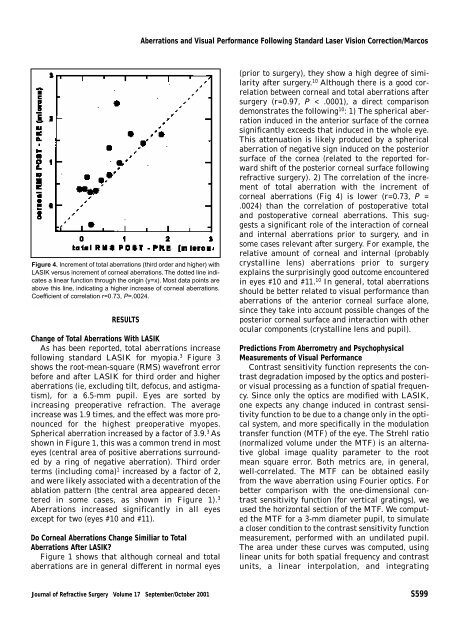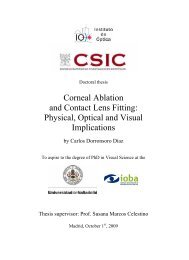Aberrations and visual performance following standard laser vision ...
Aberrations and visual performance following standard laser vision ...
Aberrations and visual performance following standard laser vision ...
Create successful ePaper yourself
Turn your PDF publications into a flip-book with our unique Google optimized e-Paper software.
<strong>Aberrations</strong> <strong>and</strong> Visual Performance Following St<strong>and</strong>ard Laser Vision Correction/MarcosFigure 4. Increment of total aberrations (third order <strong>and</strong> higher) withLASIK versus increment of corneal aberrations. The dotted line indicatesa linear function through the origin (y=x). Most data points areabove this line, indicating a higher increase of corneal aberrations.Coefficient of correlation r=0.73, P=.0024.RESULTSChange of Total <strong>Aberrations</strong> With LASIKAs has been reported, total aberrations increase<strong>following</strong> st<strong>and</strong>ard LASIK for myopia. 3 Figure 3shows the root-mean-square (RMS) wavefront errorbefore <strong>and</strong> after LASIK for third order <strong>and</strong> higheraberrations (ie, excluding tilt, defocus, <strong>and</strong> astigmatism),for a 6.5-mm pupil. Eyes are sorted byincreasing preoperative refraction. The averageincrease was 1.9 times, <strong>and</strong> the effect was more pronouncedfor the highest preoperative myopes.Spherical aberration increased by a factor of 3.9. 3 Asshown in Figure 1, this was a common trend in mosteyes (central area of positive aberrations surroundedby a ring of negative aberration). Third orderterms (including coma) 1 increased by a factor of 2,<strong>and</strong> were likely associated with a decentration of theablation pattern (the central area appeared decenteredin some cases, as shown in Figure 1). 3<strong>Aberrations</strong> increased significantly in all eyesexcept for two (eyes #10 <strong>and</strong> #11).Do Corneal <strong>Aberrations</strong> Change Similiar to Total<strong>Aberrations</strong> After LASIK?Figure 1 shows that although corneal <strong>and</strong> totalaberrations are in general different in normal eyes(prior to surgery), they show a high degree of similarityafter surgery. 10 Although there is a good correlationbetween corneal <strong>and</strong> total aberrations aftersurgery (r=0.97, P < .0001), a direct comparisondemonstrates the <strong>following</strong> 10 : 1) The spherical aberrationinduced in the anterior surface of the corneasignificantly exceeds that induced in the whole eye.This attenuation is likely produced by a sphericalaberration of negative sign induced on the posteriorsurface of the cornea (related to the reported forwardshift of the posterior corneal surface <strong>following</strong>refractive surgery). 2) The correlation of the incrementof total aberration with the increment ofcorneal aberrations (Fig 4) is lower (r=0.73, P =.0024) than the correlation of postoperative total<strong>and</strong> postoperative corneal aberrations. This suggestsa significant role of the interaction of corneal<strong>and</strong> internal aberrations prior to surgery, <strong>and</strong> insome cases relevant after surgery. For example, therelative amount of corneal <strong>and</strong> internal (probablycrystalline lens) aberrations prior to surgeryexplains the surprisingly good outcome encounteredin eyes #10 <strong>and</strong> #11. 10 In general, total aberrationsshould be better related to <strong>visual</strong> <strong>performance</strong> thanaberrations of the anterior corneal surface alone,since they take into account possible changes of theposterior corneal surface <strong>and</strong> interaction with otherocular components (crystalline lens <strong>and</strong> pupil).Predictions From Aberrometry <strong>and</strong> PsychophysicalMeasurements of Visual PerformanceContrast sensitivity function represents the contrastdegradation imposed by the optics <strong>and</strong> posterior<strong>visual</strong> processing as a function of spatial frequency.Since only the optics are modified with LASIK,one expects any change induced in contrast sensitivityfunction to be due to a change only in the opticalsystem, <strong>and</strong> more specifically in the modulationtransfer function (MTF) of the eye. The Strehl ratio(normalized volume under the MTF) is an alternativeglobal image quality parameter to the rootmean square error. Both metrics are, in general,well-correlated. The MTF can be obtained easilyfrom the wave aberration using Fourier optics. Forbetter comparison with the one-dimensional contrastsensitivity function (for vertical gratings), weused the horizontal section of the MTF. We computedthe MTF for a 3-mm diameter pupil, to simulatea closer condition to the contrast sensitivity functionmeasurement, performed with an undilated pupil.The area under these curves was computed, usinglinear units for both spatial frequency <strong>and</strong> contrastunits, a linear interpolation, <strong>and</strong> integratingJournal of Refractive Surgery Volume 17 September/October 2001 S599











